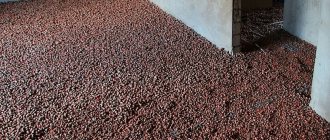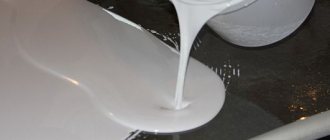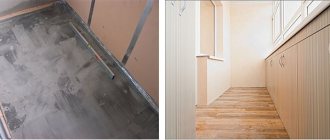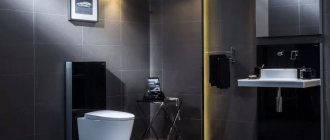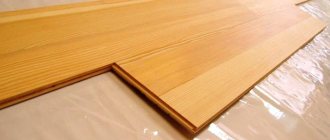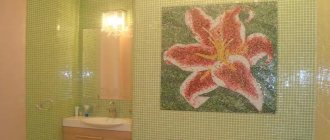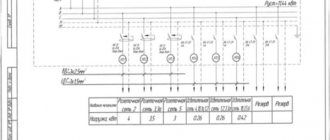Today, self-leveling flooring is a separate group of special materials applied to the surface using pouring. In fact, under their own mass, they take on the most horizontal state. With their help, the bases are leveled and protected. These floors have unique strength characteristics and have an attractive appearance even without additional finishing. But it is necessary to take into account many factors when making a self-leveling floor. One of the main ones is thickness. You should always take into account the maximum thickness of the self-leveling floor under tiles or laminate. In order to create a base, you can use any composition. But you need to take into account that they may differ in maximum thickness.
Classification of self-leveling floor
The following types of self-leveling floors can be distinguished from a wide variety:
- Mixtures for application in a thin layer. In this case, the layer thickness can be a maximum of 1 mm.
- Mixtures for application in a medium layer. In this case, it is allowed to apply the solution to the floor surface; the thickness can reach 5 mm.
- The coating is of a highly filled type, in this case the maximum layer thickness can be 8 mm.
Most often, mixtures that are applied in a thin layer are used only in industrial premises. But only if there is a low or medium load on this coating. This type of finishing coating is usually chosen based on practicality and cost-effectiveness. The maximum thickness of a self-leveling floor for an apartment can also be up to 1 mm if the rough substrate is made correctly.
Thin-layer mixtures look good and can be used to solve any design problem.
But, despite all the high economic indicators, such a coating does not have a high degree of wear resistance. It wears off quite quickly.
As for self-leveling floors of medium thickness, they have much higher characteristics than those discussed above. These mixtures can be applied even in rooms where the floor surface will be subject to fairly high mechanical loads. But they should be below the maximum value, but above the average.
The advantages of such a coating include a high degree of strength, cost-effectiveness, and maintainability. In addition, coatings of this type are quite durable. As a rule, this floor has a matte finish. But there are mixtures that are intended for use in residential buildings. They have a glossy shine. The recommended thickness of the self-leveling floor is 1-8 mm. There is no point in pouring more, since the strength will not improve significantly, but the costs will increase.
Mixtures that have a high filling level are used for difficult conditions. After polymerization and hardening, the self-leveling floor will be able to withstand high mechanical and impact loads. The wear resistance of this type of coating is very high, so these floors will be an ideal option for industrial workshops, as well as other production facilities. It is also worth noting about resistance to abrasive elements.
Self-leveling cleanroom flooring
This material is used in a room where the number of microorganisms in the air and the concentration of aerosol particles are maintained within the appropriate cleanliness class. As a rule, it is used in areas of the pharmaceutical and food industries, electronics, precision mechanics, etc. The coating ensures a tight surface, smoothness, evenness, ease of cleaning in various ways, and completely eliminates the release of contaminants.
The self-leveling floor is applied to concrete. The material for the clean room is made on the basis of polyurethane, epoxy, methyl methacrylic resins, selected in accordance with the work conditions to ensure the required cleanliness class from P0 to P9.
What thickness to choose for high loads
Quite often, self-leveling floors are used in warehouses, garages, underground parking lots, and industrial enterprises. They can be used where the floor surface is subject to mechanical or vibration loads. They can be used even in conditions with high temperature differences. On sale you can find a large number of mixtures for making self-leveling floors.
In industrial premises, it is best to use mixtures made on the basis of methyl methacrylic resins.
As a result, you will receive a coating that has very high resistance to moisture. It is not affected by ultraviolet radiation. Drying occurs literally in 2-3 hours, and there will not be a single seam on the surface.
Using such compositions you can create a variety of colored decorative surfaces. It is also worth noting the high maintainability of the coating. The maximum floor covering can withstand a load of 15 tons. Low temperatures are not scary for it; the thickness ranges from 4-6 mm.
Advantages and disadvantages
Below we present the general advantages and disadvantages of self-leveling floors.
Advantages:
- aesthetic appearance;
- relative ease of filling;
- hardness, high impact resistance;
- durability 10 years or more;
- high adhesion, the ability to pour on almost any substrate;
- hygiene, ease of cleaning and operation;
- there are no seams or joints;
- fireproof;
- resistant to various chemicals;
- maintainability.
The self-leveling floor will meet all the described advantages if the technology for filling it is fully followed.
Flaws:
- high price;
- complexity of technology;
- the floors “do not breathe”, regular ventilation of the room is necessary;
- cold, it is necessary to insulate;
- difficulty of dismantling.
Low temperature conditions
As we said, the mixtures are for use in low temperatures and are made from methyl methacrylic resin. The composition also contains various additives that improve the characteristics of the mixture. In order to ensure maximum resistance to temperature changes, it is necessary to maintain a layer thickness of 5-7 mm.
Such coatings are usually made in refrigeration chambers, in rooms adjacent to them. And let’s gradually move on to how thick the self-leveling floor should be in residential buildings.
Installation
Each coating has its own unique composition, thanks to which the characteristics of the mixture are formed. The epoxy mixture contains a resin that is characterized by strength and durability. This coating comes in several types:
- thin-layer – the thickness of the fill is up to 1 mm;
- bulk – more than 1 mm thick;
- quartz-filled - thickness greater than 1 mm, but its main difference is the layer of quartz sand.
Methyl methacrylate floors are made from flexible methyl methacrylate polymers and copolymers with the addition of quartz sand and filler. This composition dries within 15 minutes and is easily repaired without breaking the seal. This is a thin-layer composition with a thickness of 2.5 mm to 4 cm.
The polyurethane mixture consists of urethane, which is formed by the reaction between a polyol and an isocyanate. Thanks to this reaction, it has high chemical and thermal resistance. There are:
- polyurethane floors;
- polyurethane-cement floors.
The technology of pouring a floor with a polymer mixture requires the following steps:
- Preparation of the working surface. This stage involves cleaning from debris, grease, and dirt. It is also necessary to level the floor from roughness.
- Padding. An important step that improves the adhesion of the layers.
- Application of the base layer and decoration. The polymer composition is applied to a flat surface in the required layer. To ensure the surface becomes smooth, wait about 10 minutes. The drying process lasts about 5-8 hours. The last decorative layer is applied only 5 days after complete drying.
Acrylic-cement coating contains high quality cement, polyacrylic copolymers and a special filler. This mixture of substances guarantees strength and resistance to moisture. The minimum thickness is 10 mm, and the maximum is 20 mm. When filling with such a composition, you can forget about waterproofing.
The technology for installing such a floor is as follows:
Preparing the subfloor
It is important to remove the protrusions and seal the cracks. Remove all small debris using a vacuum cleaner. Surface primer for increased adhesion. Applying and leveling the solution using a spatula
It is important to work quickly as the mixture will cure within 20 minutes. To release excess air, roll the mixture with a needle roller. After a couple of hours, the surface is covered with a finishing layer (varnish, resin).
The mineral coating consists of sand, cement, expanded clay concrete. Polystyrene foam can also be used for thermal insulation under mineral composition. Subsequently, such a floor will require a finishing coating. Highlight:
- Base layer – thickness from 10 to 80 mm, dries in about 12 hours;
- Middle layer – thickness from 7 to 30 mm, drying period – about 4 hours;
- The finishing layer is 3-10 mm, dries in 4 hours.
The self-leveling cement-polymer composition has good adhesion to the base layer. This is one of the types of concrete coating, which includes cement mixtures, quartz sand, pigment and polymer additives. The optimal thickness can be up to 5 cm. It can have a matte or glossy surface.
Antibacterial floors are a durable coating system that eliminates mildew, mold and pathogenic microorganisms.
The thickness of the self-leveling floor depends on the load that the floor covering will withstand. In residential premises it will be 1.5 mm. This will be enough to not remember about repairs for many years
But it is important to consider for what purpose this or that room will be used. The choice of material and layer thickness also depend on this.
A 5 mm thick polyurethane material may be suitable for the kitchen, since this is where heavy objects often fall on the floor, and this coating has elastic properties.
Epoxy compounds are perfect for the bathroom. This is due to its high resistance to moisture. The layer thickness will be about 1.5-2.5 mm.
Methyl methacrylate compounds are suitable for the hallway and living room. Layer of material – 3-4 mm.
But in industrial facilities, the layer of self-leveling floor can vary within 10-15 cm, since the load on it in such premises is much greater. Therefore, saving on material, the coating will quickly come out of the layer.
To determine how much mixture you need, you need to take into account the thickness of the coating. For example, if the total area of the premises is 50 sq. meters, and the thickness of the filling surface is 2 mm, then you need to purchase approximately 100 liters of material. If the mixture is denser, then 150 liters. If you want to reduce consumption, use additives that will increase the volume of the material.
Self-leveling floors in a residential building
Now let's talk about residential buildings. As you understand, it is unlikely that every homeowner will be able to allocate large funds for the production of a self-leveling floor. This is one of the problems encountered during renovation and construction. In addition, you may encounter the fact that the rough base is very crooked. Please note that the amount of building material used, and therefore the financial investment, depends entirely on the thickness of the coating. Therefore, it is necessary to know what thickness to make the floor in order to avoid large financial investments.
When creating a self-leveling floor, literally every millimeter must be taken into account. For example, coatings made from polymer materials have very high strength. Therefore, in private houses or apartments a very thin layer, up to 1 mm, is enough. In this case, you will forget about repairing the flooring for a long time. But it is best to entrust all work to professionals. The smaller the layer, the less you will spend on purchasing materials. It must be taken into account that there may be potholes, cracks, and depressions in the concrete screed. This will affect the consumption of mixture and money. Therefore, it is recommended to make the finishing coating of minimum thickness.
Preparation of the solution
The correct ratio of dry mixture and water is as important as preparing the base. If you add less than the required amount of water, the mixture will not acquire the necessary mobility and fluidity and, accordingly, it will become difficult or even impossible to level it
If you add less than the required amount of water, the mixture will not acquire the necessary mobility and fluidity and, accordingly, it will become difficult or even impossible to level it.
If you add more water than the required amount, the solution will turn out to be very mobile, it will spread well, but after hardening its strength will be lower than it should be, so cracks may appear. In addition, due to excess water, the main components of the leveler will settle down, and the water will remain on top, and the solution will delaminate. Therefore, when pouring, you will have to control the level of the mixture using the upper water level. As a result, after pouring the self-leveling floor, the water will dry out, and the level of the floor itself will be below the calculated marks.
To avoid such problems, you must strictly adhere to the instructions for preparing the solution, which are written on the back of the leveler bag.
As a rule, the water consumption per bag is indicated there in the minimum and maximum quantities. For better spreading of the mixture, you should choose the maximum amount of water.
You should also pay attention that water is poured first, and then the dry mixture is poured into it. This minimizes its sticking to the walls of the container and prevents the formation of lumps.
When kneading, do not use too high mixer speeds. This leads to the enrichment of the solution with air bubbles, which subsequently form pores in the frozen finished floor.
After mixing according to the instructions, be sure to let the mixture stand for three to five minutes, during which all the necessary chemical reactions will take place and air bubbles will come out of the solution. After that, mix a little again and start pouring the floor.
Save floor mixture
If you are applying a topcoat, you do not need to make a thick self-leveling floor. Please note that it is the type of coating that is usually used in houses and apartments. As a base, you can use basic and medium compositions. These mixtures are not very expensive; they are made on the basis of sand, gypsum, cement, and plasticizers.
They do not contain polymers, so this layer can be laid even with maximum thickness.
But it is advisable to use such mixtures only to level out large uneven areas. For example, using base mixtures you can make the thickness of which will reach 8 cm. The thickness value should be about one centimeter. The finishing layer must be applied on top of the base layer; its thickness will be minimal. Moreover, you should not make the maximum thickness of the self-leveling floor under the laminate more than 1 mm. But you can’t save much either, since the laminate can bend during use.
Layer structure
To understand at what stage the reinforcement is carried out, it is worth disassembling the structure of the floor on the ground, as the most complex structure:
- Compacted soil.
- Rough pouring of concrete. It is not reinforced; cement and sand diluted with water are used for filling.
- Vapor barrier - this layer is required, otherwise the insulation will suffer from negative influences, and this will affect its quality.
- Concrete screed with reinforcement; at this stage, fiberglass is added to the composition or a reinforcing mesh is embedded inside. It is important that it is placed in the middle of the concrete mixture layer.
- After drying, any self-leveling floor - cement or polymer - is poured on top.
Optimal layer thickness
Polymer mixtures have one drawback - their cost. But they also have an advantage - the thickness of the coating should be very small. For example, if the mixture is based on polyurethane, then the optimal thickness for it will be 2.5 mm. If you need to make a glossy layer or paint it later, it is enough to apply no more than 0.5 mm of the composition. The maximum layer for polyurethane compounds is 5 mm. There is no point in making the thickness more than 5 mm, since this will not increase the strength much, but you will spend more money.
Epoxy bases have similar characteristics. The optimal thickness is about 2.5 mm. In this case, you will get good strength characteristics; the floor can withstand any load that may occur in the house.
Methyl methacrylate mixtures can be applied in a very thin layer. But it’s best not to skimp on them. To achieve quality, it is necessary to apply a layer of more than 8 mm.
Device Features
When installing self-leveling floors, the master or the owner of the premises must comply with the requirements of current regulations, as well as the technological map. When applying the composition, the following nuances are taken into account:
- The self-leveling floor should be applied exclusively on top of a solid surface with a minimum porosity coefficient.
Preparation for self-leveling floor
- Before installing the material, it is necessary to remove dust from the screed and clean it of all solid particles and other debris.
Dust removal of screed
- To improve the adhesive properties of the material, before installing it, a layer of penetrating primer should be applied over the subfloor.
Penetrating primer for screed
- The self-leveling floor is an inextricable material, which requires careful preparation for installation. Before installing it, it is necessary to glue a damper polymer tape around the perimeter of the room to avoid destruction of the material due to linear expansion.
Rolling out self-leveling floor
- When installing a coating over an area of more than 50 - 60 m2, expansion joints made of angle steel or polymer materials are required.
Expansion joints
- When mixing a dry mixture, you should strictly adhere to the instructions on the packaging, observe the required proportions of water in relation to the dry material, and also ensure that solid particles are completely dissolved in the liquid. When lumps form, the finished coating loses its uniformity and strength properties.
Mixing the naive floor
- The self-leveling floor should be applied evenly; after installation, the coating is smoothed using special hard rollers.
Roller for self-leveling floor
If you follow the above technological map and use a high-quality composition, the self-leveling floor will serve for many years without complaints. After installation of the material, the finishing coating can be laid only after the surface has completely dried and reached the design strength dictated by the manufacturer.
Self-coating in the apartment
The installation of a self-leveling floor should be entrusted to professionals, since an experienced specialist will always be able to prepare a high-quality composition that will not be destroyed, regardless of operating conditions.
Coating installation by professionals
Advice from professionals
To get a high-quality surface without extra costs, you can use the techniques of experienced specialists. For example, if the base is fairly level and there is no major damage, it can be fixed quite easily. You will get rid of the purchase of a basic or medium bulk composition and save on repairs. Using a sander, you need to carefully sand the floor surface. This will smooth out all the unevenness, as a result you will significantly save on building materials.
As a primer, you can use a dry mixture for self-leveling floors. It must be diluted in water. After that, a thin layer should be applied using a roller on the base of the floor. As soon as the primer has dried, you can begin pouring the finishing coat.
When making a self-leveling floor with your own hands, step-by-step instructions will help you follow the required sequence:
- Prepare the base for the subfloor.
- Apply the subfloor mixture. It could even be a simple cement-sand mixture.
- Level the base.
- Apply primer to the surface of the subfloor.
- Apply self-leveling floor.
- After the surface has dried, you can begin painting it or installing laminate, tile, or linoleum.
In order to obtain the highest quality surface at an affordable price, experts use some techniques.
What is the essence of reinforcement?
The self-leveling coating itself - cement or polymer - does not need reinforcement, because it is already strong. But it cannot be applied to any base. The surface will have to be prepared first. It is precisely in the layers of the rough or preparatory base that the reinforcing material is laid.
Laying beacons for pouring the mixture
Bookmarking beacons
Important! The explanation for why the layers under a naive floor are reinforced is simple - if the base coating is strong, then the top layer will last longer, it will not have to hold the poorly set mixture in the lower layers.
Reinforcement is performed using metal mesh or fiber-fiber materials, which are added to the concrete during mixing.
Structure of reinforced screed
Thick Layers
When making a thick layer, experts recommend using leveling mixtures rather than self-leveling floors. It is worth noting that, depending on the manufacturer, the compositions may have different properties. For example, one company may produce products that can be installed as thick as 80mm. And another may offer seemingly similar materials, but they can be used to make a layer of 100 mm without any problems.
If possible, use concrete mortar to level large differences. Leveling mixtures are not suitable for finishing coats.
Experts do not recommend making the thickest possible coating - the floors will take a very long time to harden. To achieve high quality, you will need to maintain constant temperature and humidity. To make a self-leveling floor with your own hands, step-by-step instructions are given a little higher. It is enough to adhere to the work algorithm to get a high-quality layer.
Where is which - we distribute the compositions throughout the apartment
You can also save on the correct placement of accents - where what composition should be used. For example, in the kitchen, only a polyurethane floor can be the final coating, because there most often heavy things fall to the ground, water, grease, and detergents spill there. It is best to use a polyurethane surface in office premises, in a word, where there is more traffic. In addition, polyurethane is very elastic, which means it does not care about constant changes in temperature conditions in the case of installing heated floors.
Epoxy compounds are best suited for rooms with high humidity - they are not affected by moisture. Moreover, in the bathroom the floor is unlikely to be threatened by anything heavier than a bottle of shampoo or a bar of soap. You should not lay them on top of a heated floor - epoxy resins do not react well to temperatures above +50 ° C, and may crack after some time under the influence of heat.
Methyl methacrylate self-leveling floors consist of acrylate resins and hardeners, which accelerate the already short drying time of the solution. By the way, you should work with such a composition with open windows and in a respirator - for the first few hours during and after pouring, there will be an unpleasant, pungent odor in the rooms, a kind of payment for speed. They are strong and durable enough to serve you in the living room and hallway, and they feel comfortable with constant changes in temperature, having the widest operating range: -70 ° C and +150 ° C.
Mineral mortars and polymer-cement mortars are suitable as the bottom layer of a self-leveling floor or a base for floor coverings such as laminate
But here, too, caution should be exercised. For example, a gypsum sand composition is not at all suitable for foundations in wet rooms (bathroom, toilet), but it would be appropriate in a living room or bedroom. https://www.youtube.com/embed/28rwom0XORk
Thin floor
Such mixtures are not used to level the surface. They are used to make the finishing coating. The minimum layer is 1 mm, the maximum value is 10 mm. When pouring and working with the finishing layer, you need to take into account that the mixtures harden quickly.
The quality of the floor does not depend on thickness at all. Therefore, you need to adhere to the maximum thickness of the self-leveling floor. To get a high-quality surface with minimal investment, you need to prepare the base. The composition must be selected based on the conditions in which the floor will be used in the future. As you understand, the maximum value of 10 mm should not be achieved if the floor is installed in a private house or apartment.
Reinforcement order
In order for any mixture to become durable, it is important to carry out the process correctly and compose the layers of the floor “pie” in the required order. First of all, prepare the rough coating - it is cleaned of dust and dirt. In order for the concrete layer to be firmly bonded to the base, it is important to cover it with a primer.
Pouring the mixture onto the reinforcing mesh
Next, fix the beacons on the plane, preferably metal ones; they should be placed approximately in the middle of the future layer. Reinforcing mesh will be laid on them. Next, the selected reinforcing material is fixed and concrete is poured. It is important that the mixture penetrates all areas of the floor, that is, it completely fills the mesh.
After this, wait 30 minutes and rub the surface until the coating is completely even. When the concrete has completely hardened, and this will happen after 30 days, you can install the self-leveling floor.
Cases of using polypropylene mesh for reinforcing concrete mixtures
Reinforcement of a concrete floor: what are the advantages and methods
The construction of industrial facilities involves the implementation of a complex of works, including the organization of a reliable floor. It is the floor that will take on various loads.
For proper installation, it is necessary to reinforce the concrete floor. This will increase the stability of the structure and ensure that the floor will be used for many decades.
Preparation: marking work
Installation of an industrial base must begin with the calculation of the loads that will be placed on it on average. The maximum load must be determined based on the purpose of the premises. If this is a warehouse, then the height of the racks, their weight and design should be taken into account. Reinforced industrial floors must withstand enormous mechanical loads. After determining the loads, a project is drawn up.
It includes calculated indicators, namely:
- materials used;
- floor thickness;
- quality indicators of concrete;
- location of seams;
- floor reinforcement methods and others;
Also, if necessary, soil compaction is carried out using vibratory rollers. The preparatory stage also includes leveling the area to be poured.
Reinforcement methods
So, everything is ready to start pouring the floor with concrete. It is important that there are as few seams as possible. To do this, the room is divided into maps. The number of cards is equal to the number of days of work. One of three methods can be used as a method of reinforcing the base.
The first method is to reinforce the floor with mesh. Metal mesh is most often used for installing floors in pedestrian crossings and parking lots.
Reinforcing mesh
The essence of the second method is strict adherence to all points of the project. Throughout the installation, the accuracy of the mesh location is monitored. So-called fiber-reinforced concrete floors can also be used.
Synthetic fiber
Beginning of work
At the first stage, the solution is poured into the cards and leveled. After this, the solution must be compacted using a vibration device, especially in areas near walls and columns. There is a lot of information available on how to reinforce a floor. But doing the work yourself, without involving specialists, will be difficult.
After all, the following take part in this process:
- vibration machines;
- grinding machines;
- equipment for vacuuming (to remove excess water);
Second phase
After removing excess moisture, the floor is grouted and the surface is treated with a special hardening impregnation. A reinforced concrete floor will be durable if high-quality raw materials are used for leveling. For example, for reinforcing self-leveling floors, Volma Leveling and Glims are ideal options.
Tip: In order for the screed to gain its properties, you need to spray its surface with water for several days. This will help prevent defects and cracks from appearing in the future. After a solution has been applied to the base to retain the required amount of moisture, the floor surface is covered with polyethylene. Self-leveling floor
Recommended by experts
It is advisable to use basalt mesh as reinforcement materials. At the moment, this is the most innovative material with excellent characteristics. When constructing a base, a reinforced mesh for the floor with a mesh size of 15×15 is suitable for screeds with a thickness of 4 cm or more. Professionals advise approaching this issue extremely responsibly. Firstly, what should be the thickness of the screed. If a screed thickness of more than 8 cm is expected, then reinforcement is indispensable.
Such points as the composition of basic and additional materials, methods and methods of work must be determined. The most inexpensive and practical method of reinforcement is the use of fiber.
Screed technologies
When solving the problem of how reinforcement will be carried out, experts settle on one of three methods:
- Pulling fittings. In this case, reinforcing mesh for heated floors with a screed thickness of up to 10 cm can be used.
- Method of dispersion reinforcement. This method involves the use of fiber.
- Application of composite materials.
- Combined method.
Non-metallic (composite) reinforcement
Rules for constructing a foundation on the ground
As in all other methods, when organizing a screed on the ground, preparatory work is carried out to reinforce the floor on the ground. The device for screeding on the ground is relevant for garages and floors. In addition to the above work, soil excavation, formwork installation, protection and strengthening of the base are carried out.
Reinforcement of the floor on the ground involves a number of measures aimed at improving the properties of the soil. Excavation is carried out to a depth of up to 35 cm. When choosing the thickness of the structure, the location of groundwater is taken into account.
Polymer mixtures: required thickness for volume effect
Popular polymer compositions (mainly polyurethane for domestic and commercial premises) can, unlike mineral mixtures, be transparent and colorless (tinted). Thanks to this property, it is possible to create so-called 3D floors. To obtain a visible volume of a flat pattern applied to a special film or paper, single or multiple pouring is performed, and the thickness of the self-leveling polymer floor can reach 5...20 mm. The more layers and the higher the fill overall, the more voluminous and vibrant the image appears.
How many centimeters of self-leveling flooring will be required to achieve the effect depends on the nature of the pattern and direction. In some cases, the volume is visible only from one (several) points, in others it constantly accompanies the view from above.
The apparent depth of the floor does not correspond to the actual thickness; a thin layer of self-leveling floor with high transparency successfully creates the impression of a multi-meter space thanks to a special pattern printing technology.
When using fillers, the question of how many cm (mm) a self-leveling floor should have depends on the size of the filler. One common design option is a flooring made from relatively thin cross-sections of wood followed by filling with epoxy resin or a transparent polyurethane compound - providing a three-dimensional effect with significantly less pouring mixture consumption. The minimum layer of self-leveling floor in such cases is 3..5 mm from the highest point of the base filled with raw materials.
Types of coatings
There are a huge number of mixtures used for self-leveling floors. At the same time, they have completely different thicknesses, which are necessary for laying a high-quality coating. Among them are:
- Thin-layer. The layer thickness does not exceed 5 mm. The main function of such a floor is to protect the base from environmental factors. Its quantity will depend on the type of mixture, manufacturer, and quality obtained. If you add a little more and make the consistency higher, the strength will increase slightly.
- Self-leveling. Such a layer can reach a height of 20 mm. It has excellent antistatic properties and can easily cope with numerous mechanical loads.
- Highly filled. It cannot be laid in a layer less than 20 mm. The composition of such mixtures most often includes quartz sand, magnesite, expanded clay, etc. This somewhat reduces the cost of the finished mixture for diluting the solution.
Acrylic-cement bulk mixtures
Having already become a classic, the mixture is suitable for those areas where the loads are extremely high. The coating is relevant for wet industries, various warehouses, and garages. As for thickness, to obtain high wear resistance characteristics, the layer is made from 10 to 20 mm. The material has excellent resistance to various types of chemicals, and is also durable, but subject to a minimum thickness.
When you can hardly do without strengthening
There are a number of cases when concrete needs to be reinforced, but you need to sort out the main tasks of reinforcement in advance:
- Protection against small cracks. Any floor does not look beautiful if cracks appear on it, self-leveling
is no exception. - Protection against the occurrence and increase of coating defects under the influence of vibration.
- Strengthening the base.
- Protection against screed subsidence.
- Increased service life of the floor.
The mixture will be strengthened by a polypropylene mesh
Reinforcement will be required primarily in these cases, primarily in these cases:
- If the base is unstable, floating. This applies to layered floors where sound insulation is used. In practice, such a floor is not attached to the base; it has the ability to “float” minimally.
- Under any circumstances during the installation of heavy structures: stoves, fireplaces, machine tools and mechanisms.
- If the thickness of the layer that is installed on the floor is more than 5 cm.
Mesh Component
Minimum thickness or thin technology
In the technology of creating self-leveling floors, every millimeter is important. For example, coatings based on polymer mixtures are highly durable. In an apartment or house, a layer of 1 mm will be enough to forget about repairs for a very, very long time. But in order for the floor to turn out exactly like this, it must be done by real professionals. A small layer means low costs for materials, but in the screed you can often find various sinks, potholes, and depressions. This will entail increased consumption of solution and funds. In this case, the finishing layer must be kept minimal.
